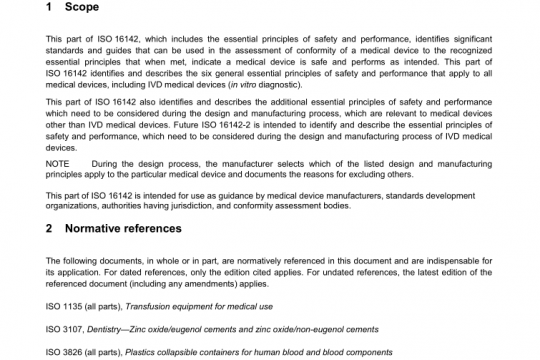AAMI TIR16 pdf free download
AAMI TIR16 pdf free download.Process development and performance qualification for ethylene oxide sterilization— Microbiological aspects.
2 Terms and definitions For the purposes of this TIR, the following terms, definitions, and abbreviations apply: 2.1 bioburden: Populations of viable microorganisms on a product unit. 2.2 biological indicator (BI): Inoculated carrier that is contained within its primary package and that provides a known resistance to the relevant sterilization process. 2.3 compromised tissue: Skin or mucous membrane that has been intentionally or accidentally opened, exposed, or breached. 2.4 dunnage: Material that exhibits density, temperature, humidity, and EO absorption characteristics similar to those of the actual product load. 2.5 fractional cycle: Sterilization cycle in which exposure to the sterilizing agent is abbreviated. 2.6 inoculated carrier: Carrier on which a defined number of test organisms have been deposited.2.7 installation qualification (IQ): Obtaining and documenting evidence that equipment has been provided and installed in accordance with its specification. 2.8 operational qualification (OQ): Obtaining and documenting evidence that installed equipment operates within predetermined limits when used in accordance with its operational procedures. 2.9 performance qualification (PQ): Obtaining and documenting evidence that the equipment, as installed and operated in accordance with operational procedures, consistently performs in accordance with predetermined criteria and thereby yields product which meets specifications. 2.10 process challenge device (PCD): Object that simulates the worst case of conditions as they are given for the sterilizing agent(s) in the items of the goods to be sterilized. NOTE 1 —The design of the process challenge device depends on the kind of goods to be sterilized and the sterilization procedure. The device should be so constituted that a biological indicator can be arranged in the place most difficult for the sterilant to reach. The biological indicator should not interfere with the function of the process challenge device. NOTE 2—In some process challenge devices, an inoculated carrier may be used in place of a biological indicator.3 Sterilization process development 3.1 Sterilization equipment Guidelines for equipment selection can be found in AAMI TIR1 5:1 997, Ethylene oxide sterilization equipment, process considerations, and pertinent calculations (AAMI 1 997b). Careful selection of the sterilizing equipment and development of the facility design will enable a manufacturer to process a product safely and effectively. 3.2 Cycle development—Physical parameters 3.2.1 Introduction This section discusses variables that have a significant effect during the sterilization of products: ethylene oxide (EO) concentration, relative humidity (RH), temperature, and EO exposure time. EO concentration and RH are calculated as prescribed in AAMI TIR1 5:1 997 (AAMI 1 997b). It is recommended that vacuum and gas rates are defined initially to minimize their effect on the cycle lethality throughout the program. These rates should be incorporated in the final process specifications as appropriate for chamber parameters. It is also important to remember that the actual depth and rate of evacuations might be different for the air-removal versus the sterilant-removal phases because the product and packaging have been exposed to increased temperature, humidity, and sterilant levels prior to the sterilant-removal phase. 3.2.2 EO concentration Common practice is to develop and validate cycles using an EO concentration ranging from 400 to 650 milligrams per liter (mg/L). It is acceptable to use lower EO concentrations, provided that the sterilization validation acceptance criteria are met. When EO concentrations higher than 650 mg/L are used, the possible increase in EO residuals should be considered.AAMI TIR16 pdf download.
Other IEC Standards
-

ANSI AAMI ISO 16142-1 pdf free download – non-IVD medical devices and guidance on the selection of standards
AAMI standards list DOWNLOAD -

ANSI AAMI ISO 16142-2 pdf free download – General essential principles and additional specifc essential principles
AAMI standards list DOWNLOAD


